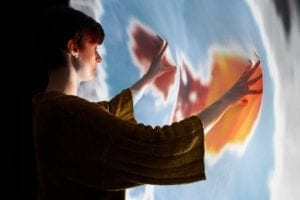Interaction Lab Research Report
Although I was unable to accompany the class during the field trip, my independent journey to the Chronus exhibition was quite intriguing. I enjoyed how the various sculpture installations were not only aesthetically captivating but also conceptually profound. The piece that stuck out to me the most was Martin Howse’s Test Execution Host. The art installation was composed of several elements, such as rocks, plastic jugs, running water, metal rods, and a computer monitor. Although it was hard to understand the conceptual purpose of this piece, I enjoyed the creative effort of compiling natural or seemingly incompatible materials with technology. This is something I’ve yet to see in other exhibits of non-technology based work, as the conceptual ideologies or metaphors are mainly contained in things that seem natural. When using technology in art, I am constantly being reminded that this is something human-made. This ability for technology in the art to have this effect makes these conceptual ideas much more apparent and offers a more profound expression for artists to share their ideas.
The first interactive art piece that comes to mind is the one I encountered at the Rubin Museum in New York during my semester abroad. The collection of pieces, curated by Elena Pakhoutova, is titled The Power of Intention: Reinventing the (Prayer) Wheel. The project is a compilation of works made by various contemporary artists focusing on the reinvention of the prayer wheel, which is known to be a tool used by Tibetan monks containing a roll of repeated mantras for spiritual guidance. The work that gave me inspiration to even take this class is Scenocosme’s Metamorphy. This piece consists of a circular cloth that activates these mandala-like images when pressed upon. For me, I enjoyed how the interactiveness of artwork can align with the conceptual ideology of that piece. The purpose of Metamorphy takes inspiration from this prayer wheel and reinvents this interaction with sensors and LED lights. In my final project, I would really like to include something that not only has aesthetic appeal but also carries meaning to its conceptual origin.

Metamorphy by Scenocosme
An example of an interactive piece that was rather unsuccessful was the Rain Room at the LACMA. My experience in this immersive art piece, although extraordinary fascinating and fun, does not work well with my definition of a successful interactive artwork. Essentially, the work is an immersive room with perpetually falling rain that stops whenever people are detected. Therefore, the concept of the room is to walk in the rain without getting rained on. Although I think the technical accomplishments of this piece are fascinating, I think it does not allow participants to properly interact; in fact, they don’t interact at all. My response to this work was simply that it is fun to walk in a room of rain without getting wet. The failure came in that there was no attachment to some conceptual ideology that spoke something more profound or offered some unique insight into the artist’s perspective.

Rain Room by Random International
Looking back, I would still define interaction as a metaphorical conversation. However, since having researched more interactive pieces and attending the Chronus exhibit, I would have to add one more idea that I believe makes an interaction truly successful. I think that interactive work should allow for a recipient to gain something new after encountering the interaction. This something new could be a piece of knowledge, an emotional experience, a reflection, or an idea. This idea is exactly in line with what Bret Victor writes in his article about the need for vision in current interactive artworks as “visions give people a direction and inspire people to act, and a group of inspired people is the most powerful force in the world.” For me, the prayer wheel works were successful because they allowed me to reflect on this spiritual practice in a new form, whereas the second artwork gave a rather unimpactful experience.
Works Cited
https://rubinmuseum.org/events/exhibitions/the-power-of-intention
https://www.lacma.org/art/exhibition/rain-room
http://worrydream.com/ABriefRantOnTheFutureOfInteractionDesign/